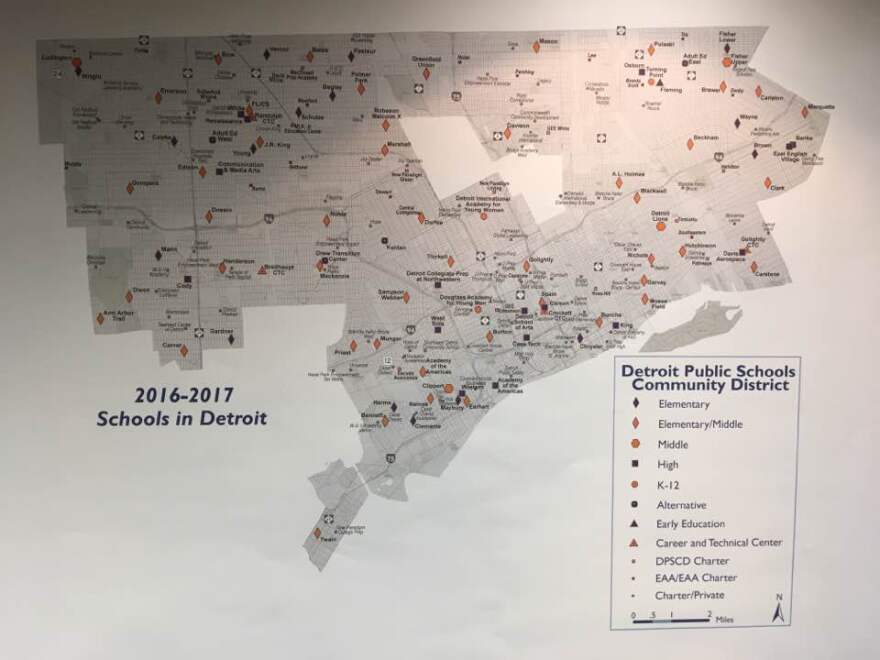Lansing spent $617 million last year to keep the Detroit Public Schools alive. That solved the district’s massive debt problem, but it didn’t start to touch some of the district’s other chronic issues.
A year ago, Detroit schools were in genuine crisis. The district was cycling through state-appointed emergency managers, and faced the prospect of going bankrupt before the end of the school year.
And that was just some of the turmoil.
State “bailout” helped, but not enough
“The teacher sickouts were happening, issues about our facilities were being broadcast nationally, there was great tension between the emergency manager and the staff, if you will,” says Alycia Meriweather, the district’s interim superintendent. “And all these things were happening simultaneously.”
Meriweather didn’t take on that role until Judge Steven Rhodes—then just taking over as the district’s fifth emergency manager in seven years—appointed her in March. But she’s been with the district for more than 20 years, first as a teacher and then as an administrator.
Meriweather says she noticed something when she walked into her first high-level staff meeting last year.
"I looked around the room and realized no one on this table has ever worked in a school."
“When I came to the first cabinet, I looked around the room and realized no one on this table has ever worked in a school,” she says.
That changed almost immediately once Meriweather came on board. And so did a few other things.
That’s because Lansing did finally intervene with that bankruptcy-style restructuring package, to keep the district from actually going broke.
In a certain way, it worked. The district expects to finish this year with a budget surplus. Enrollment basically stayed the same. And the district got additional money to make some critical building repairs, like the crumbling ceilings and black mold that made national headlines last year.
But Meriweather says that wasn’t enough.
“We really needed about $50 million more for facilities specifically,” she says. “We ended up with about $5 million.”
And that’s just for the buildings. The district doesn’t have money to invest in other areas—like raising teacher pay after years of cuts.
Detroit schools have a serious, ongoing teacher shortage. It’s forced them to constantly juggle grade levels and classloads, some principals to step in to teach, and put long-term, mostly uncertified subs in many classrooms.
And that’s “a huge strain,” Meriweather says.
Nina Chacker, a teacher of the deaf and hard of hearing at Schulze Academy in northwest Detroit, agrees on that point.
“Just being short a couple teachers, or throughout the year being told that we’re going to get teachers who haven’t shown up, has been major for us,” Chacker says. They’ve managed to keep class sizes reasonable, “but it’s work to keep it that way.”
Landing on the state’s priority schools list has added to that stress, Chacker says.
That list includes schools with test scores in the bottom 5% statewide. If they don’t show improvement within three years, the State School Reform Office can shut them down.
Schuzle had actually worked its way off that list, but recently found itself back on it.
Chacker says it can get demoralizing.
“It’s hard to feel like what you’re doing isn’t reflected in the way that you’re being evaluated,” she says.
"You get invested in your school. You love your school. You love your kids."
“You get invested in your school. You love your school. You love your kids. You don’t want to think of the community that you’re a part of being torn apart and people being spread out throughout the city. That’s not something that anyone should have to go through.”
“…instead of investing in us, they just want to do away with us.”
Schulze doesn’t face the threat of immediate closure this year.
But 25 Detroit schools do face that threat. Sixteen are in the Detroit Public Schools Community District.
Some students, parents, and staff recently protested those potential closures near the Osborn High School campus on Detroit’s east side.
Osborn houses three smaller schools. All face being possible shutdown this year.
Roquesha O’Neal has two kids there. She says if Osborn shuts down, she has no idea where they’ll go to school.
“I don’t know,” she says. “Because they didn’t tell me, as a parent, where we gonna, or where our children [are] gonna go? So right now I have no clue. I’m in a puzzle like everybody else.”
The state sent O’Neal a list of school districts her kids might be able to attend if Osborn closes.
Some of them are up to 50 miles away—districts like Monroe, East China, and Whitmore Lake. Some of them, as of now, don’t even accept Detroit students.
And that really worries O’Neal and other parents here. Because pretty much every other public high school on Detroit’s east side has either already shut down—or is also on the closure list.
“I’m looking into home schooling,” O’Neal says. “Because I feel, if I can’t get a quality education in my community, the next step is home schooling.”
Fellow Osborn parent Andrea Jackson says what many people in Detroit feel: this could spell the end for the district. And they blame the state.
"The kids are depressed. The families are depressed."
“The kids are depressed, the families are depressed,” Jackson says. “It’s like every time you turn around, instead of investing in us, they just want to do away with us. That’s just how we feel.”
But the district is prepared to fight back this time.
School board members—newly-elected and mostly-empowered for the first time in eight years—recently gave the go-ahead to sue, if the state moves ahead with closing schools.

Interim superintendent Alycia Meriweather would rather put those schools in rapid turnaround mode. She says it’s “just not acceptable” to shut down so many schools in a city that’s already lost more than 150 since 2009.
“I’m not standing here saying, don’t close schools,” Meriweather says. “I’m standing here saying, there’s a lot of data that needs to be considered, and closed schools don’t improve.”
We should know more about how that fight shapes up at the start of next month.






